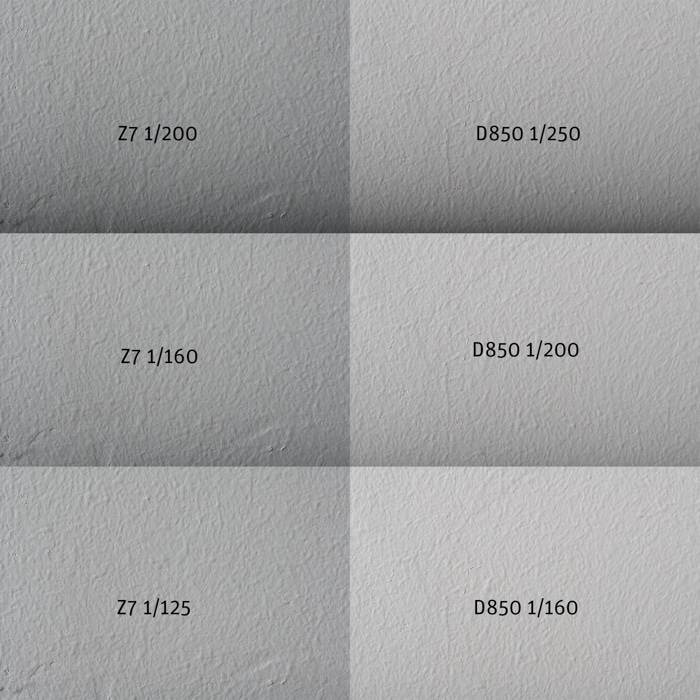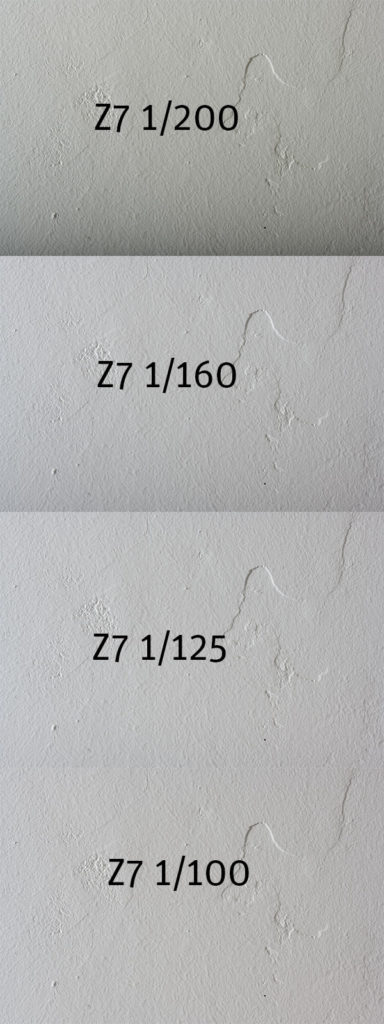This is one in a series of posts on the Nikon Z6 and Z7. You should be able to find all the posts about that camera in the Category List on the right sidebar, below the Articles widget. There’s a drop-down menu there that you can use to get to all the posts in this series; just look for “Nikon Z6/7”.
There have been reports of the Z7 not achieving its specified maximum strobe synch speed with some studio strobes at full output. I had noticed the same effect with some of the Sony a7x cameras, so I did a series of tests with the Godox AD 600 TTL Pro, the Godox pro radio trigger (not the newest version, since I don’t have mine yet) with a Nikon 105/2.8 macro and the flash set for a full pop. I tested with both a Z7 and a D850.
The maximum synch speed for the Z7 is specified as 1/200 second. For the D850, it’s 1/250. You can see that with both cameras there is considerable shading at the specified synch speed, slight shading 1/3 stop slower than that, and essentially none 2/3 stop slower than the spec.
I tried again using a hot-shoe-to-PC converter and a synch cord to the strobe.
It’s a little better, but not much. It looks like, at high shutter speeds, the trailing curtain is affecting the gradation.
If you dial back the power on the strobe, which makes the duration shorter, the problem goes away.
At full power, the strobe duration is about 1/220 second.


Jim,
Thanks a lot for your detailed analysis and sharing here on the blog.
I am in the process of buying either
* a Nikon flash or
* a Godox flash
for my Nikon Z7. Can you still recommend the Godox based on your experience?
@stefferber
I can recommend the Godox enthusiastically. I don’t like he AD200, though, since it doesn’t take standard light modifiers, but I do like the AD600 family, and the new AD400 looks good, too. I have never used a Godox hot-shoe flash.
this is horrible. for me based on these images the z7 has a sync speed of 1/125sec
the grading on 1/160sec might be unusable for critical work
Need some help getting my Phottix Indra500 to fire with my new Nikon Z 7. I apologize for jumping on this thread, but it’s the closest discussion I can find on this topic. I have been using my Phottix HSS trigger and strobes with my D850 and just assumed it would work easily with the Z 7. Not the case. I must be missing a simple setting (?).
Many thanks for the help!
Curt
Sorry, I know nothing about the Phottix.
Hi Jim –
>It’s a little better, but not much. It looks like,
>at high shutter speeds, the trailing curtain is affecting the gradation.
The AD600Pro is an IGBT controlled strobe (it supports HSS).
It has two modes of flash termination, depending on the power setting.
At full power, IGBT-controlled strobes are not (I haven’t heard of one) terminated by IGBT. The flash pulse decays slowly, almost exponentially, like a traditional strobe.
At half power and below, the flash pulse is terminated sharply by IGBT. At half-power, the flash pulse will be terminated at roughly the T.5 time of a full-power pulse.
>If you dial back the power on the strobe, which makes the duration shorter, the problem goes away.
You are now in IGBT-controlled mode, and you’ve chopped off the tail of the flash pulse. T.5==T.1==T.001
Does the problem go away, or reduce, if the power is turned down by just 0.3EV?
>Note that from the density variations at the top of the images, the strobe duration appears to be longer than 1/200 second.
Time to get out a *digital* scope, and a photodiode 🙂
The Alien Bees Einstein manual tells us pretty much what we need to know, unlike any other flash manual I’ve seen (I haven’t sen that many).
I have an even bigger issue with my Z 7 and a set of Bowens Studio strobes (1500) triggered by the newest pocket wizards.
At 1/180 its kind of a roulette, sometimes its shading like on a 1/200, sometimes I have a shuttercurtain in the frame and then it comes in various sizes…
Asked my Nikon Service, they told me to put it on mechanical shutter not the electronic or silence mode. Problem is: it is set as mechanical shutter.
Any ideas? I might send it in to service it but I somehow guess that it has to do with an off timed sync. When I set the camera to 1/60 there is no problem but I don‘t want to because sometimes (especially on sunny days) the studios get quite bright and then I have natural light incoming….
What happens when you synch with a PC cord?
You mean tethered? I always shoot tethered in the studio. Or do you mean, like oldschool with a sync cable from camera to strobe? In that case, I don‘t have the cable since I shoot wireless for over a decade now.
Doesn‘t make a difference if capturing with Capture One or Lightroom or shooting directly from the camera.
I‘ll try various sync speeds and also strobe power but I don‘t know when I’ll get to that…
I meant using a hardwired synch cable between the flash and the camera. Even if you don’t intend to shoot that way routinely, the experiment will help you figure out where the problem lies.